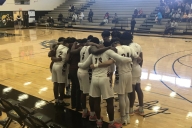You have /5 articles left.
Sign up for a free account or log in.
Jim Tressel celebrated one year of working in student affairs this week, and the answer to everyone’s burning question is yes.
Yes, he’s still wearing sweater vests to work.
“But they happen to be navy blue, not scarlet,” he said in an interview this week. “In this role, I have to put a little sport coat over it or something.”
While the wardrobe hasn’t changed, plenty of other things have. In some ways, Tressel’s new position as vice president for strategic engagement at the University of Akron is a natural one: he works on recruiting, student success and alumni relations (among other things) -- all areas he dabbled in as head coach of the behemoth football team at Ohio State University from 2001-11.
But working in administration has also provided Tressel with some clarity when it comes to his old line of work. Back then, Tressel says, he had a “tertiary relationship” with nearly everyone on campus, but didn’t fully grasp the difficulty of working in higher education as a whole – “the number of moving parts” – or the depth of what everyone was up against.
In other words, an athletics department is one unit with a singular objective and -- especially at a mega-program such as Ohio State's -- operates largely independently of the institution.
On the academic side, there are sparring colleges, thousands of faculty members, and hundreds of administrative divisions -- all of which have different goals, but must work together under the larger university umbrella. When you're trying to solve a problem -- be it signing a new television contract or getting students to graduation when budgets are low but tuition's at an all-time high -- it's generally easier with fewer people in the room (and with money to spend).
Not only is Tressel realizing the difficulty of working with so many diverse voices, he's having to consider questions and problems that people in athletics don't have to think about. How do you define student success when graduates are expected to be so versatile, how do you make success happen when money is scarce on both sides, and how do you generate successful outcomes in today's job market?
“I think we were a little spoiled in athletics – that it wasn’t hard to come to a common cause and build a team and create that oneness, and it’s a little harder with a larger group,” Tressel said. “You can see a lot more clearly, now that I’ve been here a year, as to what the challenges are in higher ed…. We felt like we were a part of it in athletics, but a smaller part, and now when you’re dealing with the broad range of things that fall in your division, it’s quite a challenge.”
Tressel has spent four decades coaching at colleges of varying size and athletics profile (including Miami University in Ohio, Syracuse University, and Youngstown State University), and he says that has given him an outlier’s perspective when it comes to the dominance of sports on campus. He shares some of the ever-growing concern that athletics has become too commercialized, demands too much of students, and is funded at the expense of the academy. Tressel especially worries that athletics sucks up all the athletes’ time and leaves them no room for anything else.
“That marketing and television and all of the funds that are involved in major college athletics have certainly taken a little bit of control, not just for the institution, but I think it’s affected the experience for the youngsters,” he said. “It’s not necessarily what I believe in, and I worry a little bit that there’s so much time invested into that singular passion, that -- are we giving them the experiences that they are going to need through the rest of their lives?”
Tressel says he’s always been cognizant and concerned about the cost of athletics to other students – the non-athletes who pay (continually rising) fees to support the enterprise, especially at a university like Akron, where three in 10 students would be considered nontraditional. But he also suggested that discontent with the funding and prominence of athletics tends to rise and fall with the tide of success.
“With athletics, sometimes it’s the fashionable thing and sometimes it’s looked upon as being something that’s a luxury that maybe we can’t afford,” Tressel said. “Like anything else, having the happy medium is what we need to do.”
Tressel resigned as Ohio State's coach in May 2011, brought down by an explosive (and some say overblown) scandal in which up to dozens of athletes, throughout most of Tressel’s tenure, exchanged memorabilia for tattoos and cash in violation of National Collegiate Athletic Association policy. Such rule-breaking would deem those athletes ineligible for competition. When the story broke, Tressel professed ignorance; a few months later, the coach admitted he had known what was going on. Despite initial support from the university, Tressel ultimately resigned as the scandal deepened and pressure mounted. After an investigation, the NCAA banned Ohio State's football team from the following postseason.
Looking back on his exit, Tressel talks about how ego prevents coaches from making changes. His career ending when it did was “a blessing,” he says.
“It gave me that opportunity to step back and say, O.K., I’ve always said I’m going to one day enter the academic sector in one way, shape or form; let’s have it be this way,” said Tressel, who studied to be a teacher in college. “You never know why things happen and the timing that occurs, but I feel very fortunate that it did.”
Tressel’s administrative position came about by happenstance. Akron President Luis Proenza reached out to Tressel for advice when he was looking for a new head football coach last year, in a phone call that involved his gauging Tressel’s interest in taking the position himself (though the two disagree on how serious this query was). But it became clear that Tressel, an Akron alum, was not interested in returning to coaching. (There was one obstacle to that idea, too: a show-cause order that the NCAA laid on Tressel as part of the Ohio State sanctions. The five-year decree meant that if Tressel left Ohio State, he would carry all the penalties incurred there along with him unless Akron could convince the NCAA they should not. The order only prevented Tressel from coaching some football games; it would not affect his administrative position.)
“His heart was in education, in building student success, and really doing what he had originally set out to be when he was a graduate student here,” Proenza said. Tressel seemed to be the perfect person to spearhead the university’s “Akron Experience,” a student engagement and success project. So, the president called Tressel back a few days later with a different offer: come work in student affairs, in a position we’ll carve out just for you. Lucky for both, the timing was perfect. (The administrative division had an opening at the top, but Proenza tailored the job to Tressel’s talents.)
The concept for Tressel’s position – something akin to a vice president for student affairs, but more wide-ranging – was that he would link recruiting efforts and the alumni base to create a path through the university for students. In non-jargon speak, that means using alumni and everything else at Tressel’s disposal to bring students to campus who already know what they’re in for, and know how to succeed once they get there. Proenza said that students go wild for Tressel, and that his stature and reputation make him the perfect motivator for them.
“The beauty of it is, kids are kids and people are people, and if they first and foremost feel that you care about them and that you really are there to serve them, it’s easy,” Tressel said. “I’ve had the chance to hone those skills for many, many, many years, and to me it’s second nature to want to see what I can do for someone.”
Tressel has about 200 staff members working under him, in areas including advising, admissions, and career counseling. And while Proenza says the former coach has brought the staff together in ways they hadn’t before, fostering new relationships, for Tressel, working with students is the highlight of the job. (Again, this passion harks back to his days as a coach – only then, he’d counsel the same students 10 times a week. Now, he’s meeting new students every day, and struggling to keep up with e-mails from thousands of them.)
The other day, a hard-worn but determined student came into Tressel’s office. Homeless, he’d been “fighting like crazy” to stay in school. He’d sneaked into a residence hall and stayed there until he got thrown out. After that, someone he met in class found room for him.
“He said, I’m gonna make it, and I just want to sit and talk and let’s do some planning,” Tressel said. “Those kinds of things we did every day with our student-athletes.”
It’s been a big and at times overwhelming learning curve, Tressel said, and something of a blur.
“My wife teases me that I’m working more hours now than I did when I was coaching, but there’s never been a day when I haven’t looked forward to trying to figure something out,” he said. “I just wish I had a few more hours in the day because there’s so many kids here you’d love to have more time with.”








